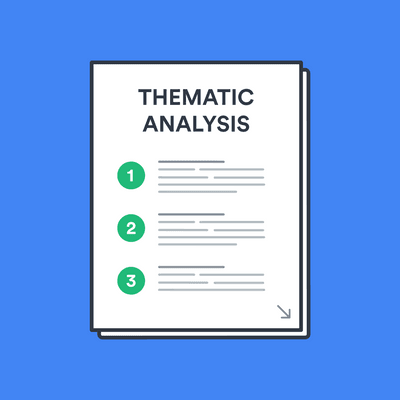How to do a thematic analysis

What is a thematic analysis?
Thematic analysis is a broad term that describes an approach to analyzing qualitative data. This approach can encompass diverse methods and is usually applied to a collection of texts, such as survey responses and transcriptions of interviews or focus group discussions. Learn more about different research methods.
A researcher performing a thematic analysis will study a set of data to pinpoint repeating patterns, or themes, in the topics and ideas that are expressed in the texts.
In analyzing qualitative data, thematic analysis focuses on concepts, opinions, and experiences, as opposed to pure statistics. This requires an approach to data that is complex and exploratory and can be anchored by different philosophical and conceptual foundations.
A six-step system was developed to help establish clarity and rigor around this process, and it is this system that is most commonly used when conducting a thematic analysis. The six steps are:
- Familiarization
- Generating codes
- Generating themes
- Reviewing themes
- Defining and naming themes
- Creating the report
It is important to note that even though the six steps are listed in sequence, thematic analysis is not necessarily a linear process that advances forward in a one-way, predictable fashion from step one through step six. Rather, it involves a more fluid shifting back and forth between the phases, adjusting to accommodate new insights when they arise.
And arriving at insight is a key goal of this approach. A good thematic analysis doesn’t just seek to present or summarize data. It interprets and makes a statement about it; it extracts meaning from the data.
When is thematic analysis used?
Since thematic analysis is used to study qualitative data, it works best in cases where you’re looking to gather information about people’s views, values, opinions, experiences, and knowledge.
Some examples of research questions that thematic analysis can be used to answer are:
- What are senior citizens’ experiences of long-term care homes?
- How do women view social media sites as a tool for professional networking?
- How do non-religious people perceive the role of the church in a society?
- What are financial analysts’ ideas and opinions about cryptocurrency?
To begin answering these questions, you would need to gather data from participants who can provide relevant responses. Once you have the data, you would then analyze and interpret it.
Because you’re dealing with personal views and opinions, there is a lot of room for flexibility in terms of how you interpret the data. In this way, thematic analysis is systematic but not purely scientific.
Braun and Clarke’s Reflexive Thematic Analysis
A landmark 2006 paper by Victoria Braun and Victoria Clarke (“Using thematic analysis in psychology”) established parameters around thematic analysis—what it is and how to go about it in a systematic way—which had until then been widely used but poorly defined.
Since then, their work has been updated, with the name being revised, notably, to “reflexive thematic analysis.”
One common misconception that Braun and Clarke have taken pains to clarify about their work is that they do not believe that themes “emerge” from the data. To think otherwise is problematic since this suggests that meaning is somehow inherent to the data and that a researcher is merely an objective medium who identifies that meaning.
Conversely, Braun and Clarke view analysis as an interactive process in which the researcher is an active participant in constructing meaning, rather than simply identifying it.
The six stages they presented in their paper are still the benchmark for conducting a thematic analysis. They are presented below.
The six steps of thematic analysis
1. Familiarizing
This step is where you take a broad, high-level view of your data, looking at it as a whole and taking note of your first impressions.
This typically involves reading through written survey responses and other texts, transcribing audio, and recording any patterns that you notice. It’s important to read through and revisit the data in its entirety several times during this stage so that you develop a thorough grasp of all your data.
2. Generating Initial Codes
After familiarizing yourself with your data, the next step is coding notable features of the data in a methodical way. This often means highlighting portions of the text and applying labels, aka codes, to them that describe the nature of their content.
In our example scenario, we’re researching the experiences of women over the age of 50 on professional networking social media sites. Interviews were conducted to gather data, with the following excerpt from one interview.
| Interview snippet | Codes |
|---|---|
It’s hard to get a handle on it. It’s so different from how things used to be done, when networking was about handshakes and business cards. | Confusion Comparison with old networking methods |
It makes me feel like a dinosaur. | Sense of being left behind |
Plus, I've been burned a few times. I'll spend time making what I think are professional connections with male peers, only for the conversation to unexpectedly turn romantic on me. It seems like a lot of men use these sites as a way to meet women, not to develop their careers. It's stressful, to be honest. | Discomfort and unease Unexpected experience with other users |
In the example interview snippet, portions have been highlighted and coded. The codes describe the idea or perception described in the text.
It pays to be exhaustive and thorough at this stage. Good practice involves scrutinizing the data several times, since new information and insight may become apparent upon further review that didn’t jump out at first glance. Multiple rounds of analysis also allow for the generation of more new codes.
Once the text is thoroughly reviewed, it’s time to collate the data into groups according to their code.
3. Generating themes
Now that we’ve created our codes, we can examine them, identify patterns within them, and begin generating themes.
Keep in mind that themes are more encompassing than codes. In general, you’ll be bundling multiple codes into a single theme.
To draw on the example we used above about women and networking through social media, codes could be combined into themes in the following way:
| Codes | Theme |
|---|---|
Confusion, Discomfort and unease, Unexpected experience with other users | Negative experience |
Comparison with old networking methods, Sense of being left behind | Perceived lack of skills |
You’ll also be curating your codes and may elect to discard some on the basis that they are too broad or not directly relevant. You may also choose to redefine some of your codes as themes and integrate other codes into them. It all depends on the purpose and goal of your research.
4. Reviewing themes
This is the stage where we check that the themes we’ve generated accurately and relevantly represent the data they are based on. Once again, it’s beneficial to take a thorough, back-and-forth approach that includes review, assessment, comparison, and inquiry. The following questions can support the review:
- Has anything been overlooked?
- Are the themes definitively supported by the data?
- Is there any room for improvement?
5. Defining and naming themes
With your final list of themes in hand, the next step is to name and define them.
In defining them, we want to nail down the meaning of each theme and, importantly, how it allows us to make sense of the data.
Once you have your themes defined, you’ll need to apply a concise and straightforward name to each one.
In our example, our “perceived lack of skills” may be adjusted to reflect that the texts expressed uncertainty about skills rather than the definitive absence of them. In this case, a more apt name for the theme might be “questions about competence.”
6. Creating the report
To finish the process, we put our findings down in writing. As with all scholarly writing, a thematic analysis should open with an introduction section that explains the research question and approach.
This is followed by a statement about the methodology that includes how data was collected and how the thematic analysis was performed.
Each theme is addressed in detail in the results section, with attention paid to the frequency and presence of the themes in the data, as well as what they mean, and with examples from the data included as supporting evidence.
The conclusion section describes how the analysis answers the research question and summarizes the key points.
In our example, the conclusion may assert that it is common for women over the age of 50 to have negative experiences on professional networking sites, and that these are often tied to interactions with other users and a sense that using these sites requires specialized skills.
The advantages and disadvantages of thematic analysis
Advantages
Thematic analysis is useful for analyzing large data sets, and it allows a lot of flexibility in terms of designing theoretical and research frameworks. Moreover, it supports the generation and interpretation of themes that are backed by data.
Disadvantages
There are times when thematic analysis is not the best approach to take because it can be highly subjective, and, in seeking to identify broad patterns, it can overlook nuance in the data.
What’s more, researchers must be judicious about reflecting on how their own position and perspective bears on their interpretations of the data and if they are imposing meaning that is not there or failing to pick up on meaning that is.
In Closing
Thematic analysis offers a flexible and recursive way to approach qualitative data that has the potential to yield valuable insights about people’s opinions, views, and lived experience. It must be applied, however, in a conscientious fashion so as not to allow subjectivity to taint or obscure the results.
Frequently Asked Questions about thematic analysis
❓ What is the purpose of thematic analysis?
The purpose of thematic analysis is to find repeating patterns, or themes, in qualitative data. Thematic analysis can encompass diverse methods and is usually applied to a collection of texts, such as survey responses and transcriptions of interviews or focus group discussions. In analyzing qualitative data, thematic analysis focuses on concepts, opinions, and experiences, as opposed to pure statistics.
🔬 What are the advantages and disadvantages of thematic analysis?
A big advantage of thematic analysis is that it allows a lot of flexibility in terms of designing theoretical and research frameworks. It also supports the generation and interpretation of themes that are backed by data.
A disadvantage of thematic analysis is that it can be highly subjective and can overlook nuance in the data. Also, researchers must be aware of how their own position and perspective influences their interpretations of the data and if they are imposing meaning that is not there or failing to pick up on meaning that is.
📊 How many themes are in thematic analysis?
How many themes make sense in your thematic analysis of course depends on your topic and the material you are working with. In general, it makes sense to have no more than 6-10 broader themes, instead of having many really detailed ones. You can then identify further nuances and differences under each theme when you are diving deeper into the topic.
📇 Why is thematic analysis good for interviews?
Since thematic analysis is used to study qualitative data, it works best in cases where you’re looking to gather information about people’s views, values, opinions, experiences, and knowledge. Therefore, it makes sense to use thematic analysis for interviews.
💾 What is coding in thematic analysis?
After familiarizing yourself with your data, the first step of a thematic analysis is coding notable features of the data in a methodical way. This often means highlighting portions of the text and applying labels, aka codes, to them that describe the nature of their content.


